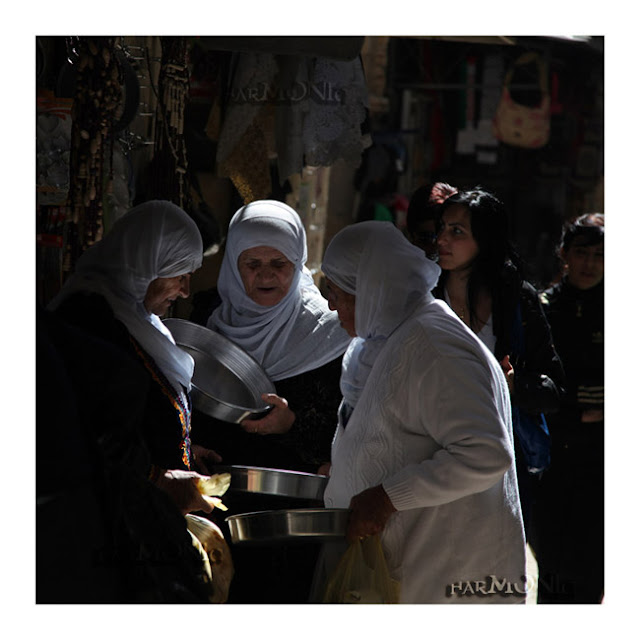Although only about 20% of the population of the country are Muslims, in Jerusalem you don't see that it is only minority. Muslim quarter is loud, colourful and lively.
Life of many Palestinian concentrates in their quarter of Old City - here they have their shops targeting mostly turists, here they create market every day which is mostly for local people and consist of veg and fruits put straight on the street.
Life starts early in the morning. Young boys delivering bread from bakeries, carry the trays on their heads or in plastic bags.
Shops are so inviting with the fresh fruits, hot bread and juice squeezed from oranges and pomergranates.
The men LOVE to trade and price haggling is their speciality. In the morning most of the are in front of their shops reading magazines and enjoying the sun.
Later on - if it's not so busy they enjoy the games of blackgammon - you can see AND HEAR the excitements over the game :)
Mosques
Through the colourful streets of the Muslim Quarter we arrive to one of the most important places for Islam. Dome of the Rock and Al-Aqsa are two of the most important mosques.
Muslims believe that Muhammad was transported from the Sacred Mosque in Mecca to Al-Aqsa during the Night Journey. Islamic tradition holds that Muhammad led prayers towards this site until the seventeenth month after the emigration, when God directed him to turn towards the Ka'aba.
The mosques are open for turists only twice a day 7.30am - 10.00am and 12.00pm - 1.30pm. Of course you cannot go inside.
The rest of the time the place is devoted strictly to Muslims, who goes there with whole families spending time praying and enjoying the beautiful buildings.
Conflict
One of the biggest problem between the Jews and Muslims is the place where now exist the mosques.
The Western Wall for Jews is the point where everything began. It is the first stone of the earth. The wall is remnant of the ancient wall that surrounded the Jewish Temple's courtyard and is one of the most sacred sites in Judaism outside of the Temple Mount itself. For Jews Jesus was not the Prophet. They believe that when the real Prophet will come they will build the Temple back. Some of the Jewish Orthodox say even that they should build back the Temple now, before the Prophet comes. The problem is that the mosques are just behind the Western Wall. It is not possible to build back the Temple without destroying the mosques...
Another conflict is about the big part of the country refered to as Palestinian Territory. The Palestinian National Authority regard East Jerusalem as part of the West Bank, and consequently a part of the Palestinian territories, while Israel regards it as part of Israel as a result of its annexation in 1980. The Jews divided the country putting a big wall and no Palestinians can go to another side without security checks similar to those at the airport.
While we were walking next to the wall in Bethlehem - on the Palestinian side we´ve seen lots of graffiti and writting comparing it to the Berlin Wall. You can feel that people hate it... Such a shame that this country must be so divided.
Cementery
Walking around we discovered muslim cementery. It is situated behind the wall of the city, close to the mosques. The view from ot is just fantastic! You can see the Mount Olive with its churches, jewish cementery and olive trees. I found it strange that jewish and muslim cementeries are just oposite each other, on the other hills. Miguel explained to me that Jews believe that when the Prophet comes all the Jews will raise from their graves and go with him to the Western Wall. On the other side Muslims believe that they should be as close as possible to their mosques, even after death.
Going through the old cementery was one of the best experiences from the trip. While we were walking amongst old graves with muslim insignia, suddenly in several places started the evening call for praying. It was surreal - the song of praying, the old stones with arabic scribts, the light - everything about this moment will stay in my memory forever.


















I enjoy seeing everyday life when I travel to a place, makes memories last for me longer. I enjoy the feelings brought in each photo. The bread photo is wonderful, it's like I am almost there smelling it :) Wish you a great weekend lovely Xxxx
ReplyDeleteThank you Kizzy! It´s not so easy to take photos in these kind of places as usually Muslims don´t like to be photographed. It was easier then in Marroco for sure, but still... Have a lovely weekend xx
ReplyDeleteWow! What a surreal experience that must have been at the cemetery. It's all very sensuous - the sound, the light, the atmosphere.
ReplyDeleteRisking sounding redundant, I do love how you capture a day in the life of local people. Very evocative of what you explain succinctly in your text.
Thank you AJ! I do try to write shortly as I know many people don't want to read long texts - especially people for whom English is not mother tounge. I do love breathing in the atmosphere of the place that I visit - I like observing local people and they every day life :) thanks again for your kind comments
ReplyDeleteSome very lovely photos once again, Monika. You do people so well.
ReplyDeleteWow wonderful post , with amazing captures .
ReplyDeleteThank you Yin Mei and Team G :)
ReplyDelete